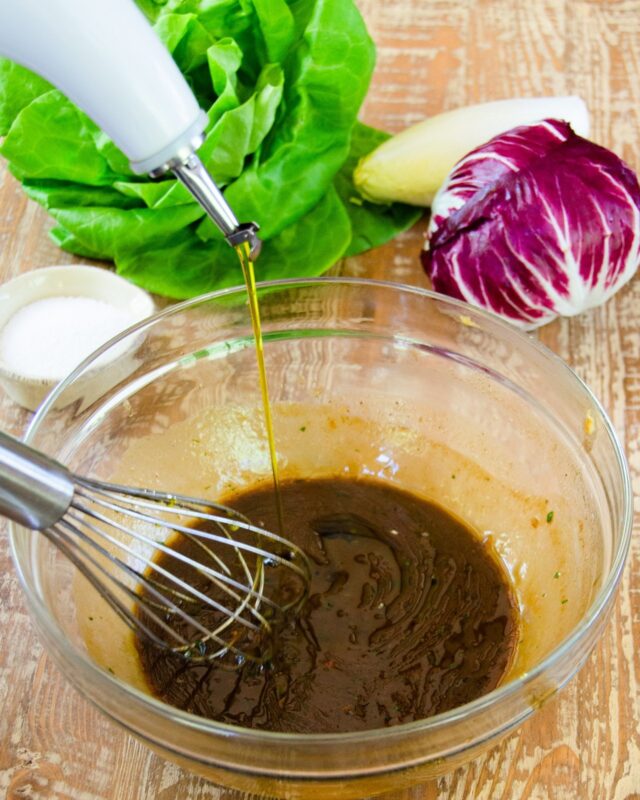If you could only know one piece of information about making a vinaigrette, it would be this… the classic ratio of oil to vinegar is 3:1 (3 parts oil to 1 part vinegar). It doesn’t really matter what vinegar or oil you are using, this ratio will give you a simple vinaigrette. Now, you may not always want to stick to this ratio depending on what you are dressing with the vinaigrette – there will be occasions when you want a little more or less acid and bite, but a three to one ratio is a great place to start.
Speaking of starting, always start with the vinegar in the bowl first. Other ingredients blend better in vinegar than in oil. Foods like mustard, sugar, salt or honey will dissolve in vinegar, but remain clumpy or grainy in oil. Items like chopped shallots will lend their flavor more readily in vinegar than in oil. So, start with the vinegar first and make the oil the last ingredient you add.
It’s no secret that oil and vinegar do not like to mix, which is why you’ll see a vinaigrette separate often. This really is not a big deal because you can (and should) always whisk the vinaigrette back together just before serving, but there is another component to a vinaigrette that can help keep the oil and vinegar in suspension. This component is called the emulsifying agent. Emulsifying agents are just like the people who are “the glue” in your family or group of friends – without them, the whole crowd never gets together. These ingredients have molecules that attract oils on one end and vinegars on the other and as a result, by adding them to the vinaigrette, they are able to keep the oil and vinegar from separating. Mustard, sugar and egg yolks are all emulsifying agents and adding one of these will help keep your vinaigrette from separating.
As with any recipe that calls for very few ingredients, always try to use the very best quality ingredients that you can. Extra virgin olive oil is made from the first cold pressing of the olives, and as such has a superior taste. A measure of a good vinegar is one that is at least 6 % acidity. Vinegars of this standard usually tell you the acidity percentage on the label. If you can’t find any information out, it probably isn’t 6% acidity.
Finally, there is one rule of thumb that I always rely on when I’m making a vinaigrette à la minute (pouring straight from both bottles onto a salad without measuring first) – always use less vinegar than you think you need, and more oil than you think you need. With that basic rule and the knowledge that you should be using about three times as much oil as vinegar, you’ll be dressing salads at the table in no time.
Quick Notes:
- The basic ratio for vinaigrette is 1:3 or one part vinegar to three parts oil.
- Always start with the vinegar and always end with the oil.
- Try to add an emulsifying agent like sugar or mustard.
- Use the best ingredients you have – extra virgin olive oil and a vinegar that is at least 6% acidity.
- If you’re making a vinaigrette à la minute, always use less vinegar than you think you need, and more oil than you think you need.











Thank you!Can’t wait to make this!
Appreciate your info. Thank you so much
You have made me a much better cook! ☺️
Thanks, MaryJo! 🙂
ML
Thank you for the recipe
Thank you, I appreciate not only your recipes but HOW to make them!